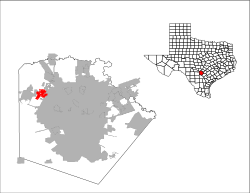Helotes
| Helotes, Texas | |
|---|---|
| City | |

The historic Floore Country Store in Helotes
|
|
 Location of Helotes, Texas |
|
 |
|
| Coordinates: 29°33′55″N 98°41′21″W / 29.56528°N 98.68917°WCoordinates: 29°33′55″N 98°41′21″W / 29.56528°N 98.68917°W | |
| Country | United States |
| State | Texas |
| County | Bexar |
| Government | |
| • Mayor | Tom Schoolcraft |
| Area | |
| • Total | 6.58 sq mi (17.03 km2) |
| • Land | 6.57 sq mi (17.02 km2) |
| • Water | 0.004 sq mi (0.01 km2) |
| Elevation | 1,037 ft (316 m) |
| Population (2010) | |
| • Total | 8,104 |
| • Density | 1,200/sq mi (480/km2) |
| Time zone | Central (CST) (UTC-6) |
| • Summer (DST) | CDT (UTC-5) |
| ZIP code | 78023 |
| Area code(s) | 210, 726 (planned) |
| FIPS code | 48-33146 |
| GNIS feature ID | 1337583 |
| ANSI Code | 2410736 |
| Website | www |
Helotes (/həˈloʊtᵻs/ hə-LOH-tiss) is a city in Bexar County, Texas, United States, located on the far northwest side of San Antonio. It is part of the San Antonio-New Braunfels Metropolitan Statistical Area. The population was 7,341 at the 2010 census.
According to anthropologists, the area was occupied seasonally from about 5,000 B.C. by small bands of nomadic Native American tribes in search of food and game. The Lipan Apache moved into the area in the late 17th century and occupied it throughout the 18th century. However, the Lipan were forced from the area in the early 1820s by the Comanche Indians.
A small farming and ranching community began to develop in the area shortly after the Texas Revolution in the late 1830s. The ranches suffered occasional attacks by the Comanches until the late 1870s.
In 1858, a Scottish immigrant, Dr. George Marnoch, purchased the land that would later become the site of the town. Marnoch's home at one time served as a stagecoach stop and a post office for cowboys driving their cattle from Bandera to auction in San Antonio. His heirs sold a portion of their property in 1880 to a Swiss immigrant, Arnold Gugger, who built a home and mercantile store around which the town of Helotes sprang to life. In 1908, Gugger sold his property to Bert Hileman, who opened the town's first dance hall. He was also instrumental in getting old Bandera Road paved and opening the town's first filling station. He sold his property in downtown Helotes in 1919, when the town's population declined.
...
Wikipedia
